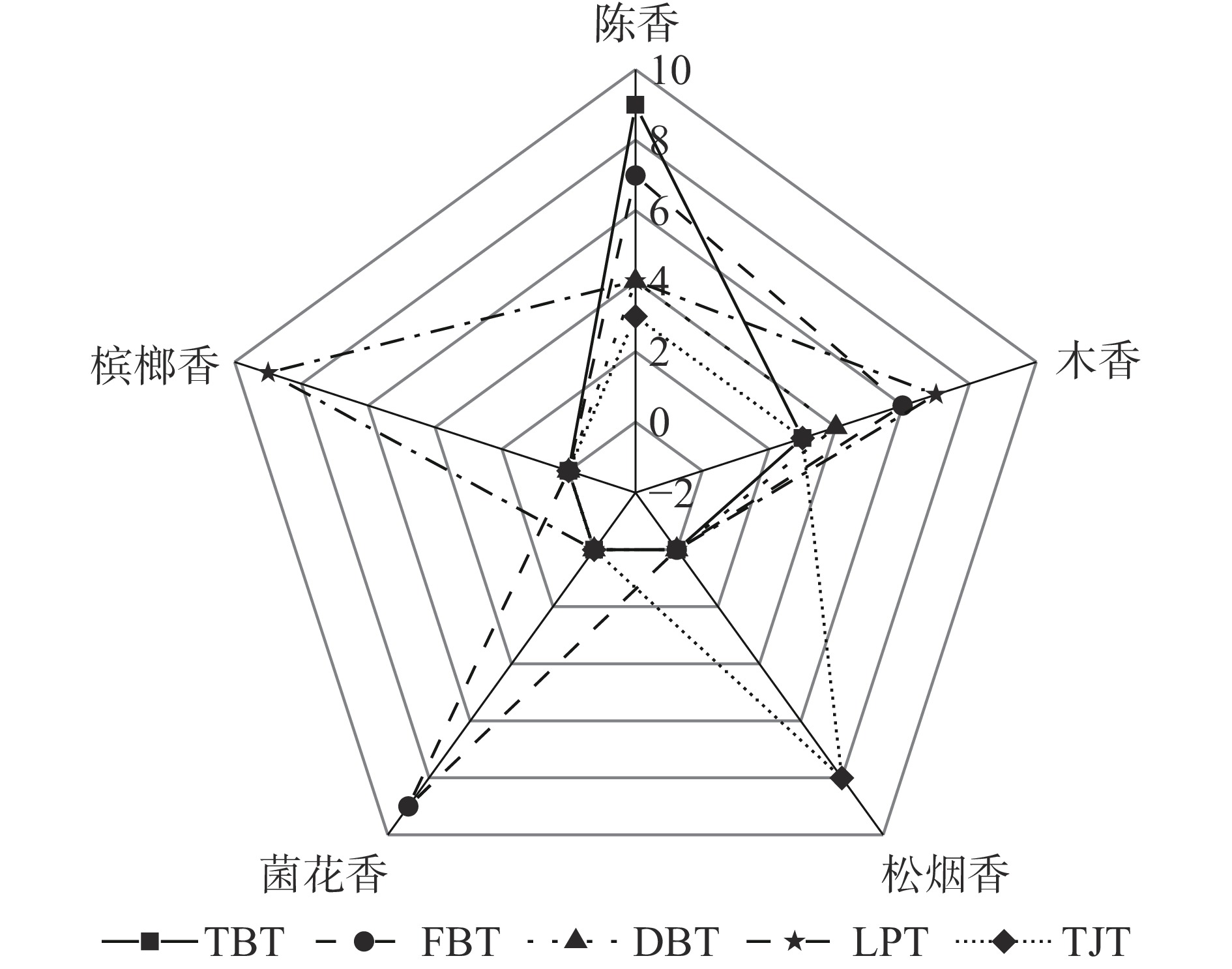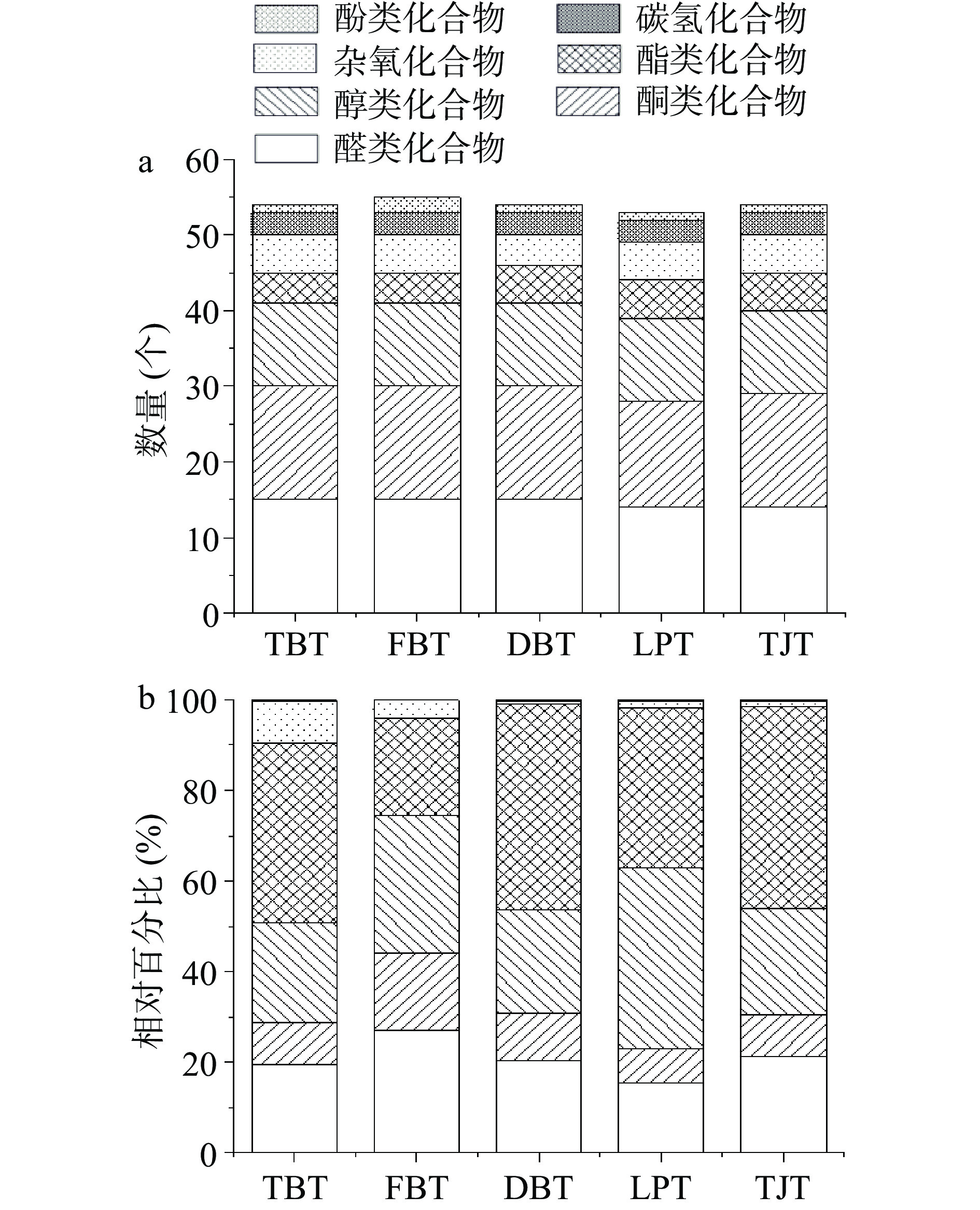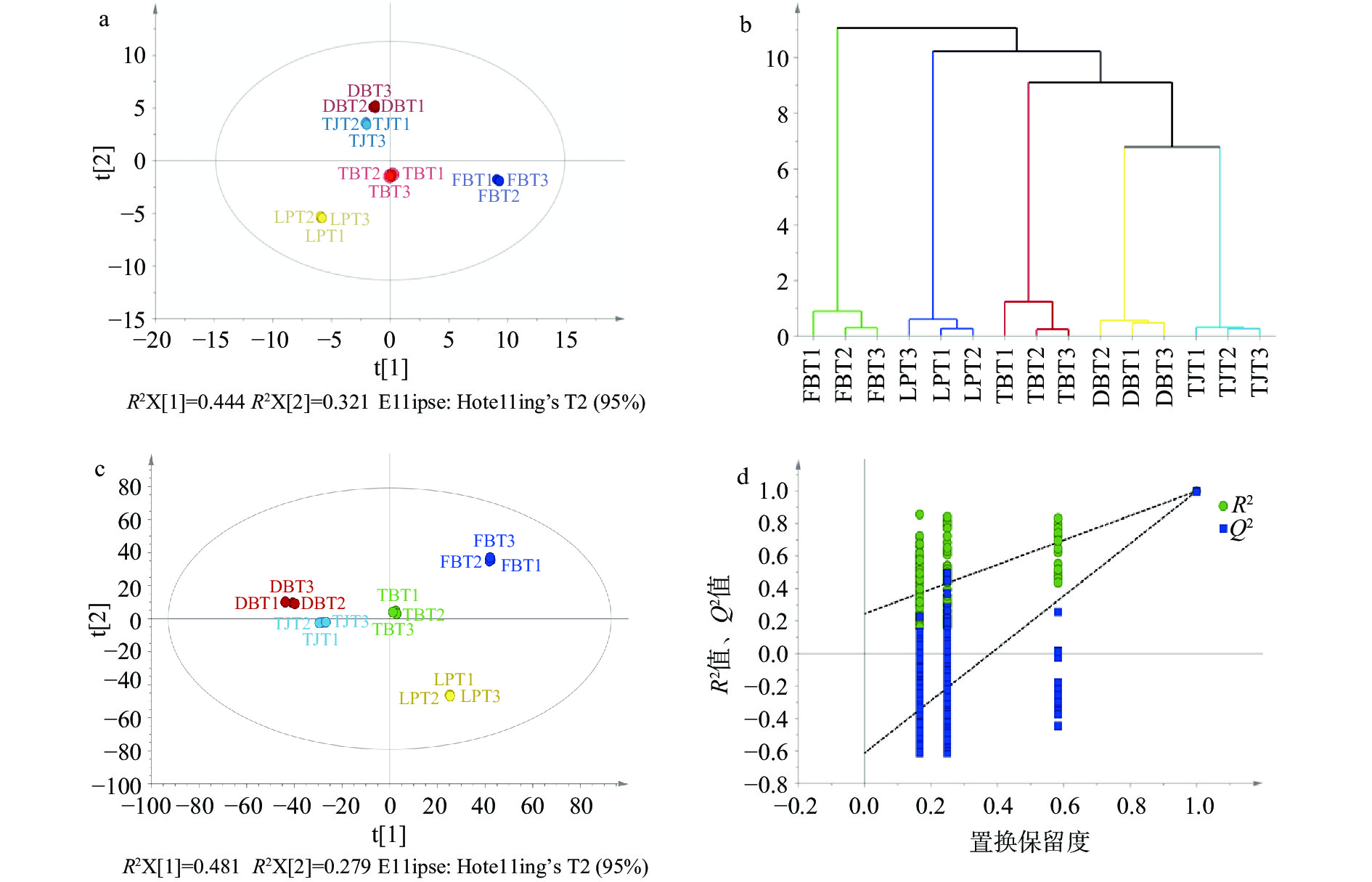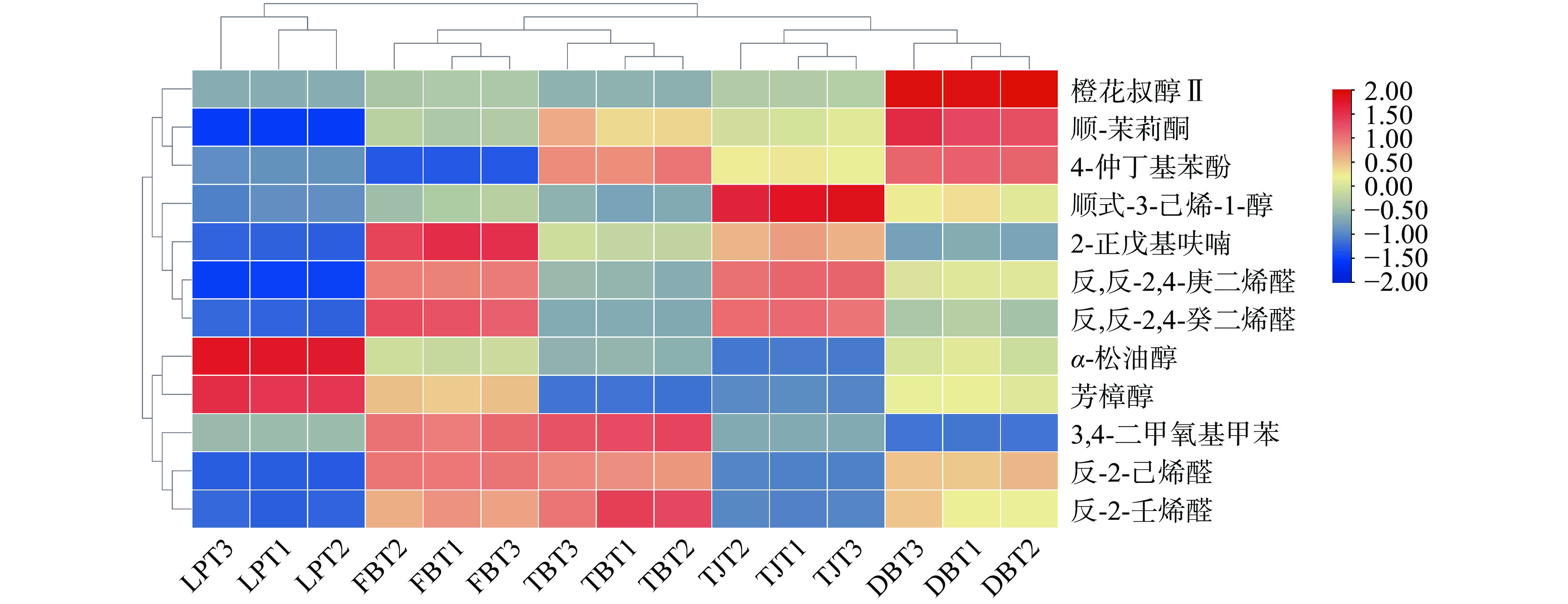Study on Aroma Components in Different Types of Dark Tea Based on HS-SPME-GC-MS
-
摘要: 为探究不同种类黑茶香气成分特征,采用顶空固相微萃取和气相色谱-质谱联用技术(Headspace solid-phase microextraction-gas chromatography-mass spectrometry,HS-SPME-GC-MS)结合感官审评对茯砖茶、黑砖、藏茶、六堡茶、天尖等五种主要黑茶样品的香气成分进行分析。结果表明,五种黑茶的香气特征明显。茯砖茶主要香气轮廓为菌花香和陈香,六堡茶具有明显持久的槟榔香与陈香,藏茶具有持久的陈香,黑砖茶香气纯正,天尖具有持久的松烟香。五种黑茶样品的感官审评总分排序为藏茶(91.35)>茯砖茶(90.15)>黑砖(89.05)>六堡茶(88.85)>天尖(86.33);五种不同的黑茶共含有56个香气成分,不同种类黑茶在香气成分构成与含量上均有差异。五种黑茶样品的香气成分总含量排序为茯砖茶(6355.30 μg/L)>藏茶(5858.73 μg/L)>黑砖(5789.71 μg/L)>天尖(4801.37 μg/L)>六堡茶(3740.14 μg/L)。根据多元统计分析以及香气活性值分析,发现1,2,3-三甲氧基苯对藏茶的陈香具有突出贡献。反,反-2,4-癸二烯醛、反,反-2,4-壬二烯醛、柠檬醛I、柠檬醛II、正己醛和水杨酸甲酯对茯砖茶的菌花香具有突出贡献,而1,2,3-三甲氧基苯则对茯砖茶的陈香具有突出贡献。(+)-雪松醇对六堡茶的槟榔香具有突出贡献。反,反-2,4-癸二烯醛、反,反-2,4-壬二烯醛、正己醛和植醇等对天尖的松烟香有突出贡献。苯乙醇、橙花叔醇II和氧化芳樟醇I等香气成分的综合作用形成了黑砖纯正的香气。本研究为探索不同种类黑茶的香气品质提供了数据参考。Abstract: Headspace solid-phase microextraction-gas chromatography-mass spectrometry (HS-SPME-GC-MS) and sensory evaluation were used to investigate the aroma characteristics of different dark tea products (Fu brick tea, Dark brick tea, Tibetan tea, Liupao tea, and Tianjian dark tea). Sensory evaluation results showed that the aroma characteristics of the five dark tea samples differed remarkably. Fungal and stale aromas were the major aroma profiles of Fu brick tea. Results showed that, Liupao tea had obvious persistent areca-like and stale aromas, Tibetan tea had a persistent stale aroma, and Dark brick tea exhibited a pure aroma feature. Furthermore, Tianjian dark tea showed a persistent smoked aroma. The following rank order of the score of the sensory evaluation in the five dark teas was observed: Tibetan tea (91.35) > Fu brick tea (90.15) > Dark brick tea (89.05) > Liupao tea (88.85) > Tianjian dark tea (86.33). A total of 56 volatile compounds were identified in the five dark teas. The composition and content of aroma components varied significantly among the different dark teas. Contents of the volatile compounds in the five dark teas with the following rank order: Fu brick tea (6355.30 μg/L) > Tibetan tea (5858.73 μg/L) > Dark brick tea (5789.71 μg/L) > Tianjian dark tea (4801.37 μg/L) > Liupao tea (3740.14 μg/L). Multivariate statistical analysis and odor activity values analyses showed that 1,2,3-trimethoxybenzene was the characteristic volatile component of the stale aroma of Tibetan tea. (E,E)-2, 4-decadienal, (E,E)-2, 4-nonadienal, citral I, citral II, hexanal, and methyl salicylate contributed to the fungal aroma of Fu brick tea, while 1,2,3-trimethoxybenzene was the key contributor to the stale aroma of Fu brick tea. In Liupao tea, (+)-cedrol was a major contributor to the areca-like aroma. (E,E)-2, 4-decadienal, (E,E)-2, 4-nonadienal, hexanal, and phytol were the main contributors to the pine-smoked aroma of Tianjian dark tea. The pure aroma of Dark brick tea was formed by the comprehensive action of many volatile components, including benzene ethanol, neroltertiary alcohol II, and oxidized linalool I. This study would provide a statistical basis for exploring the aroma quality of different types of dark teas.
-
黑茶是我国特有的后发酵茶,是中国最具特色的茶类之一[1-2]。近年来由于其降脂减肥、调节脂质代谢等多种健康益处而备受人们关注。随着黑茶中具有保健养生作用的功能成分被不断挖掘,黑茶已不仅限于边销或侨销,正在向外销市场扩张,出口东南亚、日本等地区[3-4]。黑茶产区广,可因特殊制作工艺与不同产地分成许多不同种类:茯砖茶、天尖、六堡茶、黑砖、藏茶等[5]。
由于原料、产地以及制作工艺等诸多因素影响,不同黑茶种类形成了各种独特的香气品质特征。天尖和六堡茶是篓装散茶的一类。天尖由特级、一级黑毛茶加工制得,通常带有松烟香[6]。六堡茶常以槟榔香和松烟香闻名[7-8]。茯砖茶和黑砖属于砖形紧压黑茶。茯砖茶砖块内布满冠突散囊菌,俗称“金花”,“发花”这一独特工序赋予茯砖茶独特的菌花香[9-10]。黑砖香气纯正带有松烟香[11]。藏茶主要产于四川省,由于畅销青藏高原地区而得名[12-13]。藏茶主要香气类型是陈香[14-15]。
目前针对茶叶香气成分提取的方法主要包括液-液萃取、减压蒸馏萃取、搅拌棒吸附萃取、水蒸气蒸馏法、同时蒸馏萃取法、超临界流体萃取法和固相微萃取法(Solid phase micro-extraction,SPME)等[16-17]。其中,固相微萃取中最常用的顶空固相微萃取(Headspace solid phase micro-extraction,HS-SPME)法操作简单,设备要求低,常用于提取挥发性、半挥发性有机物。该方法无需溶剂、集采样、萃取与浓缩为一体;同时,此方法对于热敏性成分提取较充分,且无有机试剂的干扰,香气还原度较好。因此,顶空固相微萃取(HS-SPME)法是提取茶叶香气成分较为常用的技术。
香气是决定茶叶品质最重要的关键因素之一,然而,目前关于黑茶香气的研究较多关注于单一产地或同种类间的比较,关于不同产地多种类黑茶间香气成分差异的相关报道较少。本文采用顶空固相微萃取和气相色谱-质谱联用(HS-SPME-GC-MS)技术对5个不同种类黑茶样品进行香气成分检测分析,明确各不同种类黑茶香气成分组成差异,可为后期黑茶香气机理研究以及品质创新等提供科学依据。
1. 材料与方法
1.1 材料与仪器
黑茶 收于各地区,均使用锡箔袋密封保存于实验室4 ℃冰箱中;藏茶 产于四川省雅安市,2016年;茯砖茶 产于湖南省益阳市,2016年;天尖 产于湖南省益阳市,2016年;黑砖 产于浙江省金华市,2016年;六堡茶 产于广西省梧州市,2016年;56种香气标准品 购于东京化成工业株式会社、美国Sigma、北京百灵威科技有限公司等。
7890B-7000C气相色谱-串联质谱仪 美国Agilent公司;75 μm CAR/PDMS SPME固相微萃取手动进样手柄和萃取头 美国Supelco公司。
1.2 实验方法
1.2.1 感官审评
感官审评参照Li等[18]的研究方法,审评人员由8名专业人员组成。
1.2.2 固相微萃取法
精确称取1 g磨碎茶样于15 mL萃取小瓶中,加入转子,再加5 mL 100 ℃蒸馏水,在80 ℃恒温水浴条件下以转速600 r/min萃取吸附60 min,GC-MS解析10 min。
1.2.3 GC-MS分析条件
GC条件:色谱柱DB-WAX(30 m×250 μm×0.25 μm),进样口温度240 ℃,载气为氦气(纯度>99.999%),柱流量为1 mL/min,分流比10∶1;升温程序为:35 ℃保持5 min,以2 ℃/min的速度升到100 ℃,保持1 min;再以5 ℃/min的速度升温至240 ℃,保持2 min。MS条件:离子源温度230 ℃,接口温度240 ℃,电离方式EI,电子能量70 eV,电子倍增器电压:1161 V,全扫描模式(Scan)下的质量扫描范围35~550 u。
1.2.4 定性定量方法
通过计算机检索与NIST05s.LIB质谱库提供的标准质谱图进行对照,以匹配度大于80%为标准,根据保留指数计算公式,结合保留时间求出各被测组分的保留指数(Retention index,RI),保留指数计算公式[19]如公式(1)所示。通过文献以及数据库的保留指数进行鉴定;将待测物质的特征离子以及RI与标准品比较进行定性。结合各色谱峰的峰面积进行香气相对含量分析,并根据检测出的各香气成分峰面积与内标(己酸乙酯)峰面积的比值进行相对定量。具体方法参照李永迪的研究方法[20]。
(1) 式中:RI为待测物质保留指数;n表示待测物质的碳数;RT(x)为待测物质的保留时间;RT(n)为待测物质流出前正构烷烃的保留时间;RT(n+1)为待测物质流出后正构烷烃的保留时间。
1.2.5 香气活性值(Odor activity value,OAV)计算
OAV为某香气成分的质量浓度与其气味阈值的比值[21-22],OAV计算公式如公式(2)所示。
(2) 式中:C为香气成分的质量浓度,μg/L;OT为该香气成分的气味阈值,μg/L。
1.3 数据处理
每组实验数据重复测定3次。采用Excel 2019软件进行各样品香气成分的数据分析;采用Origin 2021软件制作柱状图和雷达图;采用TBtools软件制作热图;采用SIMCA-P 14.1软件进行主成分分析(PCA)、层序聚类分析(HCA)、偏最小二乘判别分析(PLS-DA)和计算预测变量重要性投影(VIP);采用SPSS 27数据处理软件(IBM)进行单因素方差分析(ANOVA)中的最小显著差异法检验,P<0.05为差异显著。
2. 结果与分析
2.1 不同种类黑茶的感官审评结果分析
不同种类黑茶的感官审评结果如表1所示,感官审评综合得分为藏茶(91.35)>茯砖茶(90.15)>黑砖(89.05)>六堡茶(88.85)>天尖(86.33)。五种黑茶在汤色、滋味以及叶底等方面的差异较小;藏茶、茯砖茶、黑砖的外形相对较好。根据感官审评结果(表1)中香气部分的审评结果,将不同种类黑茶的香气特征制成雷达图(图1),雷达图的数值表示黑茶样品的某一香气特征分值,分值越高表示黑茶样品的某一香气特征越明显。结果显示,不同种类黑茶的香气特征差异较大,藏茶具有持久的陈香,茯砖茶有明显的菌花香,稍带陈香,黑砖香气纯正,六堡茶具有明显持久的槟榔香与陈香,天尖具有持久的松烟香,所有茶样均稍带木香。
表 1 黑茶样品的感官审评结果Table 1. Results of sensory evaluation of dark tea products样品 藏茶(TBT) 茯砖茶(FBT) 黑砖(DBT) 六堡茶(LPT) 天尖(TJT) 外形(20%) 评语 砖面平整,松紧
适度,呈棕褐砖面紧实,菌花明显,
呈黄褐,多梗砖面平整,有嫩梗,
净度高,呈乌褐条索紧结,较肥壮,
较嫩带毫,少许杂质条索紧结,带嫩梗,
黑褐带棕,较油润评分 89.50 91.50 88.00 80.00 85.00 汤色(10%) 评语 红亮深 橙黄 黄橙明亮 红浓 红亮 评分 90.00 91.00 91.00 92.50 92.00 香气(30%) 评语 陈香持久 菌花香持久,带陈香,带木香 纯正,持久 槟榔香持久,稍带
陈香,带木香松烟香持久 评分 91.00 90.50 90.00 92.00 85.00 滋味(35%) 评语 滑 稍涩 纯淡 浓纯爽口 稍涩 评分 93.00 89.00 88.00 90.00 86.50 叶底(5%) 评语 黑褐稍带青,带嫩梗 黄褐,有梗 黄褐,有嫩梗 较肥壮,棕褐,有梗 黄褐,带嫩梗 评分 92.00 89.00 91.00 90.00 87.00 总分 91.35 90.15 89.05 88.85 86.33 2.2 不同种类黑茶的香气成分分析
为进一步分析不同种类黑茶产生不同香型的原因,利用HS-SPME-GC-MS技术这5个黑茶样品的香气成分及含量进行分析鉴定。由表2可知,在五种黑茶中共检测到56个香气成分。根据化合物主要官能团的不同将检测到的香气成分分为7大类,其中,酮类化合物和醛类化合物最多,均为15种,醇类化合物11种,酯类化合物5种,杂氧化合物5种,碳氢化合物3种及酚类化合物2种。
表 2 不同种类黑茶的香气成分定性分析与香气含量Table 2. Qualitative analysis and aroma content of different types of dark tea序号 化合物名称 RI(实际/理论) 含量(μg/L) TBT FBT DBT LPT TJT 醛类化合物 C1 2,3-二氢-2,2,6-三甲基苯甲醛 1321/- 28.79±1.16b 45.99±1.02a 25.13±1.37c 16.92±0.78d 27.23±0.81b C2 β-环柠檬醛 1596/1611 11.47±0.44bc 18.59±0.32a 10.90±0.20c 6.60±0.09d 11.94±0.52b C3 苯乙醛 1621/1640 85.77±0.46c 87.43±3.78c 99.16±0.89b 144.22±1.21a 52.18±1.20d C4 反-2-己烯醛 1203/1216 119.15±1.94b 125.99±1.10a 104.82±2.42c 27.69±0.34e 39.16±0.83d C5 反-2-壬烯醛 1518/1534 22.40±1.39a 19.15±0.59b 16.38±0.97c 6.64±0.27e 8.19±0.11d C6 反,反-2,4-庚二烯醛 1475/1495 119.84±4.33d 221.80±1.12b 162.43±2.52c 56.39±1.26e 231.80±2.95a C7 反,反-2,4-癸二烯醛 1794/1811 13.38±0.11d 30.10±0.77a 16.11±0.70c 8.51±0.19e 28.55±0.43b C8 反,反-2,4-壬二烯醛 1684/1700 8.62±12.51c 46.53±0.60a 24.27±0.60b 8.70±0.72c 18.66±0.52bc C9 反,反-2,4-辛二烯醛 1590/1603 10.56±0.25b 15.50±0.58a 11.22±0.16b 4.45±0.34d 9.84±0.35c C10 庚醛 1174/1184 45.96±0.37b 64.18±1.68a 42.80±1.39c 16.20±0.64d 43.66±0.37c C11 癸醛 1487/1498 6.15±0.09b 9.73±0.74a 5.12±0.11c 1.31±0.31e 4.17±0.16d C12 柠檬醛I 1717/1718 3.51±0.28c 11.44±0.29a 6.27±0.30b ND ND C13 柠檬醛II 1705/1716 4.65±0.33d 16.52±0.44a 7.83±0.04b 2.65±0.54e 6.90±0.06c C14 壬醛 1382/1391 16.57±0.76b 24.52±0.51a 11.48±0.38c 2.47±0.44e 8.01±0.29d C15 正己醛 1068/1083 637.80±2.24b 974.64±4.84a 630.33±3.48b 275.33±4.85d 531.42±10.69c 总计 1134.62±13.79 1712.10±9.33 1174.24±4.22 578.08±6.36 1021.72±14.77 酮类化合物 C16 2-庚酮 1171/1182 34.39±0.89c 76.00±0.59a 23.55±1.02d 48.12±2.06b 32.32±0.79c C17 2-十一酮 1580/1598 5.50±0.17b 7.44±0.16a 1.60±0.13d 3.38±0.23c 1.38±0.34d C18 4-氧代异佛尔酮 1128/1141 27.94±1.16c 58.89±1.99a 32.25±1.67b 20.66±0.95d 21.31±0.33d C19 6-甲基-3,5-庚二烯-2-酮 1577/1602 68.58±1.98c 188.95±3.45a 81.52±3.53b 25.37±1.09e 53.75±1.71d C20 6-甲基-5-庚烯-2-酮 1326/1338 70.70±2.23b 133.97±3.79a 57.69±0.67c 44.36±1.23d 59.82±1.81c C21 α-紫罗酮 1836/1840 20.78±0.67c 57.81±0.76a 28.37±1.29b 8.90±0.45e 18.09±0.85d C22 β-紫罗酮 1926/1971 42.28±2.16c 59.39±1.82a 49.29±2.18b 20.39±0.61d 41.20±1.07c C23 苯乙酮 1628/1647 17.21±0.47b 25.02±1.25a 14.87±0.99c 18.26±0.41b 9.42±0.27d C24 对甲基苯乙酮 1776/1797 4.89±0.08b 6.60±0.36a 7.03±0.27a 4.40±0.30c 5.10±0.19b C25 二氢-β-紫罗酮 1828/1842 2.07±0.11a 0.91±0.09b 0.16±0.01c 0.92±0.10b 0.17±0.01c C26 顺-茉莉酮 1931/1961 3.38±0.27b 2.08±0.10d 4.94±0.26a ND 2.62±0.13c C27 香叶基丙酮II 1845/1859 90.43±2.09c 244.76±7.39a 122.70±3.86b 32.72±1.42e 78.17±1.86d C28 异佛尔酮 1567/1591 10.88±0.24a 10.01±0.38b 8.96±0.29c 8.98±0.35c 7.34±0.19d C29 樟脑 1499/1518 79.29±0.72a 42.33±2.27b 8.92±0.45c 9.45±0.41c 5.70±0.34d C30 植酮 2110/2131 72.35±1.13c 168.45±4.76a 165.56±1.25a 36.34±0.78d 106.98±1.89b 总计 550.67±4.28 1082.59±6.71 607.41±3.10 282.26±2.59 443.36±1.97 醇类化合物 C31 1-辛烯-3-醇 1451/1450 17.92±0.75c 38.78±1.52a 12.95±0.53d 16.37±0.55c 19.98±0.78b C32 (+)-雪松醇 2106/2116 43.10±0.47b 14.53±0.39c 13.21±0.35d 95.58±1.20a 8.23±0.24e C33 α-松油醇 1689/1690 28.80±0.97d 46.59±1.05c 50.30±3.50b 115.59±1.52a 10.14±0.56e C34 苯乙醇 1900/1906 103.74±3.66d 294.11±2.82b 518.20±8.29a 116.46±3.32c 517.57±6.89a C35 橙花叔醇I 2036/2033 30.49±1.78b 18.24±0.78c 37.45±1.18a 17.68±0.56c 31.64±1.39b C36 橙花叔醇II 2024/2030 1.75±0.18d 11.50±0.45c 106.56±1.61a 0.15±0.05e 13.53±0.57b C37 芳樟醇 1549/1547 12.45±0.41e 63.12±1.35b 52.02±2.10c 93.73±1.64a 17.48±0.67d C38 氧化芳樟醇I 1461/- 256.04±6.51c 465.48±11.97a 173.99±4.09d 450.12±11.23b 182.89±4.70d C39 氧化芳樟醇II 1432/- 711.38±13.54b 817.25±15.96a 185.60±3.10e 547.02±3.68c 213.70±2.64d C40 植醇 2608/2622 68.79±2.22c 162.23±8.67a 159.52±4.69a 33.84±0.84d 100.23±2.50b C41 顺式-3-己烯-1-醇 1382/1382 6.98±0.25d 7.99±0.34c 9.85±0.36b 6.08±0.26e 14.87±0.37a 总计 1281.44±12.67 1939.81±39.95 1319.65±8.59 1492.62±8.89 1130.26±4.11 酯类化合物 C42 二氢猕猴桃内酯 2328/2331 2298.04±38.38b 1290.95±29.12d 2583.62±87.18a 1299.50±24.76d 2102.33±34.75c C43 癸酸乙酯 1417/1425 2.75±0.09b 3.34±0.17a 2.60±0.08b 3.18±0.11a 2.74±0.08b C44 水杨酸甲酯 1754/1765 20.77±0.69d 60.61±2.76a 28.79±0.62b 12.39±0.53e 23.59±0.74c C45 乙酸苄酯 1714/- 3.99±0.14b 3.85±0.18bc 5.72±0.29a 1.00±0.03d 3.64±0.09c C46 棕榈酸甲酯 2211/2208 ND ND 7.37±0.12a 2.94±0.08b 0.58±0.03c 总计 2325.55±37.67 1358.75±27.03 2628.10±86.83 1319.00±24.08 2132.88±34.27 杂氧化合物 C47 1,2,3-三甲氧基苯 1953/1963 457.16±6.95a 186.31±6.05b 25.40±0.61d 33.68±1.09c 31.91±0.38cd C48 1,2,4-三甲氧基苯 2075/2095 66.10±2.48a 35.94±0.90b 2.94±0.03d 15.40±0.42c 3.05±0.17d C49 3,4,5-三甲氧基甲苯 2042/2041 1.59±0.06c 4.27±0.18a ND 0.50±0.08d 1.96±0.02b C50 3,4-二甲氧基甲苯 1797/1806 3.69±0.09a 3.27±0.13b 0.06±0.00e 0.97±0.01c 0.72±0.00d C51 2-正戊基呋喃 1223/1231 12.53±0.41c 24.12±0.73a 8.36±0.45d 4.60±0.14e 18.23±0.63b 总计 541.07±9.44 253.91±6.48 36.76±0.72 55.13±1.40 55.87±0.79 碳氢化合物 C52 1-甲基萘 1862/1884 1.18±0.02c 1.57±0.07a 1.03±0.04d 1.31±0.01b 1.19±0.02c C53 2-甲基萘 1826/1858 2.49±0.04b 2.82±0.06a 2.13±0.03d 2.38±0.05c 2.08±0.01d C54 β-石竹烯 1577/1595 3.33±0.08b 2.23±0.10c 0.29±0.00e 4.64±0.11a 0.76±0.01d 总计 7.00±0.10 6.62±0.11 3.45±0.06 8.33±0.14 4.03±0.05 酚类化合物 C55 2,6-二叔丁基-4-甲基苯酚 1903/1909 ND 0.03±0.00a ND ND ND C56 4-仲丁基苯酚 2050/2068 18.38±0.58b 1.48±0.01e 20.10±0.11a 4.70±0.15d 13.25±0.38c 总计 18.38±0.58 1.51±0.01 20.10±0.11 4.70±0.15 13.25±0.38 注:RI的实际值是化合物在DB-WAX上的保留指数,“−”代表未查到;ND表示未检测出;同一行中不同小写字母表示差异显著(P<0.05)。 结果显示,不同种类黑茶在香气成分的构成与含量上都有差异。五种黑茶样品的香气成分总含量排序为茯砖茶(6355.30 μg/L)>藏茶(5858.73 μg/L)>藏黑砖(5789.71 μg/L)>藏天尖(4801.37 μg/L)>藏六堡茶(3740.14 μg/L)。各样品的香气成分含量较多的种类为醛类化合物、酮类化合物、醇类化合物和酯类化合物。酮类化合物和醇类化合物多体现为花果香,醛类化合物多体现为青草香和花果香,这些化合物通常给予茶叶美好的香气[23]。茯砖茶中的醛类化合物、酮类化合物和醇类化合物的含量均为最高,茯砖茶的菌花香应与这三类化合物密切相关。在藏茶和茯砖茶中含量较高的1,2,3-三甲氧基苯和1,2,4-三甲氧基苯等杂氧化合物则会赋予茶叶陈香的香气品质。有些香气成分是某些种类黑茶特有的,如:柠檬醛I在藏茶、茯砖茶和黑砖中检测出;3,4,5-三甲氧基甲苯和顺-茉莉酮在茯砖茶、六堡茶、藏茶和天尖中检测出;棕榈酸甲酯只在黑砖、六堡茶和天尖中检测出,2,6-二叔丁基-4-甲基苯酚只在茯砖茶中检测出。总之,由于不同种类黑茶的原料、加工工艺以及制作环境等因素的影响,不同种类黑茶的香气成分存在着较大差异。
不同香气成分在不同种类的黑茶间相对含量差异显著。由图2a可知,五种黑茶的香气成分构成、化合物总数量和每类化合物间化合物数量差异不大,但由图2b可知,不同种类黑茶间的香气成分相对含量差异显著,所有茶样中香气成分质量浓度较高的酯类化合物、醇类化合物、醛类化合物以及酮类化合物,总相对含量达到90%以上。藏茶、黑砖和天尖中香气成分质量浓度最高的是酯类化合物,分别含有2325.55、2628.10、2132.88 μg/L;占各样品香气成分总含量39.69%、45.39%、44.42%。茯砖茶和六堡茶中醇类化合物成分质量浓度最高,分别含有1939.81、1492.62 μg/L,其相对含量为30.52%和39.91%。藏茶、茯砖茶、黑砖、六堡茶、天尖中质量浓度含量最高的香气成分均为二氢猕猴桃内酯,质量浓度分别为2298.04、1290.95、2583.62、1299.50、2102.33 μg/L;占各样品香气成分总含量的39.22%、20.31%、44.62%、34.74%、43.79%。这些香气成分相互影响、共同作用形成黑茶特殊的香气品质。
2.3 多组分化学计量学
OAV是结合香气成分的含量和气味阈值,对各香气成分在样品的香气贡献进行综合评价的方法[24-26]。通常认为OAV>1的香气成分对茶叶香气形成有贡献,OAV>10,则对茶叶香气形成有显著影响[27-28]。参照文献[20,23,25,29]中香气成分在水中的阈值计算出各香气成分的OAV,并记录文献所描述香气成分的香气特征。结果表明(表3),有31种香气成分OAV>1,即有31种香气成分对黑茶的香气形成有贡献。这些香气成分类型主要为醛类化合物和醇类化合物。
表 3 不同种类黑茶香气成分OAV和香气描述Table 3. OAV and aroma attributes of aroma components in different types of dark tea序号 名称 气味阈值(μg/L) OAV 香气描述 TBT FBT DBT LPT TJT C2 β-环柠檬醛 5 2.29 3.72 2.18 1.32 2.39 甜香、花果香 C3 苯乙醛 40 2.14 2.19 2.48 3.61 1.30 青草气、花香 C4 反-2-己烯醛 17 7.01 7.41 6.17 1.63 2.30 青草气、果香 C5 反-2-壬烯醛 0.4 56.01 47.87 40.96 16.61 20.47 脂香 C6 反,反-2,4-庚二烯醛 56 2.14 3.96 2.90 1.01 4.14 青草气、脂香 C7 反,反-2,4-癸二烯醛 0.16 83.60 188.15 100.71 53.20 178.46 脂香、果香 C8 反,反-2,4-壬二烯醛 0.16 53.89 290.84 151.66 54.35 116.63 脂香、青草气 C10 庚醛 10 4.60 6.42 4.28 1.62 4.37 青草气 C11 癸醛 6 1.03 1.62 <1 <1 <1 花果香、甜香 C12 柠檬醛I 0.5 7.02 22.89 12.54 − − 柠檬香 C13 柠檬醛II 0.5 9.30 33.04 15.66 5.29 13.79 柠檬香 C14 壬醛 15 1.10 1.63 <1 <1 <1 脂香、花果香 C15 正己醛 4.5 141.73 216.59 140.07 61.18 118.09 青草气、果香 C21 α-紫罗酮 10 2.08 5.78 2.84 <1 1.81 紫罗兰香 C22 β-紫罗酮 7 6.04 8.48 7.04 2.91 5.89 紫罗兰香 C27 香叶基丙酮II 60 1.51 4.08 2.04 <1 1.30 花香、青草气 C31 1-辛烯-3-醇 1.5 11.95 25.86 8.63 10.92 13.32 蘑菇香 C32 (+)-雪松醇 0.5 86.20 29.05 26.42 191.15 16.47 木香、陈香 C34 苯乙醇 390 <1 <1 1.33 <1 1.33 花香 C35 橙花叔醇I 10 3.05 1.82 3.74 1.77 3.16 花果香、甜香 C36 橙花叔醇II 10 <1 1.15 10.66 <1 1.35 花果香、甜香 C37 芳樟醇 10 1.25 6.31 5.20 9.37 1.75 花果香、木香 C38 氧化芳樟醇I 320 <1 1.45 <1 1.41 <1 花香、甜香 C39 氧化芳樟醇II 320 2.22 2.55 <1 1.71 <1 花香 C40 植醇 0.64 107.48 253.48 249.26 52.87 156.61 花香 C42 二氢猕猴桃内酯 500 4.60 2.58 5.17 2.60 4.20 麝香 C44 水杨酸甲酯 40 <1 1.52 <1 <1 <1 薄荷味 C47 1,2,3-三甲氧基苯 0.75 609.54 248.42 33.87 44.90 42.55 陈香 C48 1,2,4-三甲氧基苯 3.06 21.60 11.75 <1 5.03 1.00 陈香 C51 2-正戊基呋喃 4.8 2.61 5.02 1.74 <1 3.80 果香 C52 1-甲基萘 0.02 59.20 78.75 51.49 65.70 59.73 焦香 注:仅列出OAV>1的香气成分。 藏茶中,有27种香气成分OAV>1,其中OAV>10的香气成分有10种,1,2,3-三甲氧基苯对藏茶香气具有突出贡献。茯砖茶中香气成分OAV>1的有30种,其中OAV>10的有12种,反,反-2,4-癸二烯醛、反,反-2,4-壬二烯醛、柠檬醛I、柠檬醛II和正己醛等醛类化合物以及水杨酸甲酯对茯砖茶的菌花香具有突出贡献,而1,2,3-三甲氧基苯则对茯砖茶的陈香具有突出贡献。黑砖中香气成分OAV>1的有25种,其中OAV>10的香气成分有11种,苯乙醇、橙花叔醇II和氧化芳樟醇I等香气成分的综合作用形成了黑砖纯正的香气。在六堡茶中有22种香气成分OAV>1,其中OAV>10的香气成分有9种,(+)-雪松醇对六堡茶的槟榔香具有突出贡献。天尖中,香气成分OAV>1有25种,其中OAV>10的香气成分有10种,反,反-2,4-癸二烯醛、反,反-2,4-壬二烯醛和正己醛等醛类化合物和植醇等醇类化合物对天尖的松烟香有突出贡献。这与黄林杰[8]、蒋容港[26]和张婷等[30]的研究结果相一致。综上所述,不同种类黑茶的特征香气形成的呈香香气成分均有所不同,同一香气成分对不同种类黑茶的香气形成也有不同贡献。
为研究不同种类黑茶中显著差异的香气成分,将五组茶样的56种香气组分进行PCA,HCA和PLS-DA分析,并且结合OAV,研究不同种类黑茶中香气成分组成的差异及呈香香气成分的差异。PCA和HCA分析表明(图3a、图3b),五种黑茶可明显分为5组,表明5组样品间香气成分组成具有显著差异。基于PCA和HCA结果,构建了PLS-DA模型(图3c),拟合参数R2X=0.991、Q2=0.998,置换检验模型(图3d)R2=0.0507、Q2=−0.672,Q2回归线与纵轴的相交点小于零,表明该判别模型有较好的解释能力,且不存在过拟合现象,模型验证有效。
根据PLS-DA模型,利用VIP>1且P<0.05,共筛选出12种差异香气成分,分别为反-2-己烯醛、反-2-壬烯醛、反,反-2,4-庚二烯醛、反,反-2,4-癸二烯醛、α-松油醇、橙花叔醇II、芳樟醇、顺式-3-己烯-1-醇、3,4-二甲氧基甲苯、2-正戊基呋喃、顺-茉莉酮以及4-仲丁基苯酚,将12种差异香气成分含量制成热图(图4)。其中,有7种差异香气成分OAV>1,分别是:反-2-己烯醛、反-2-壬烯醛、反,反-2,4-庚二烯醛、反,反-2,4-癸二烯醛、橙花叔醇II、芳樟醇以及2-正戊基呋喃。
3. 结论
本研究采用感官审评对茯砖茶、黑砖、藏茶、六堡茶和天尖这五个不同种类黑茶进行综合评价。结果显示:藏茶具有持久的陈香,茯砖茶有明显的菌花香,带陈香,黑砖香气纯正,六堡茶具有明显持久的槟榔香与陈香,天尖具有持久的松烟香。
采用HS-SPME-GC-MS技术对这五个不同种类黑茶的香气成分进行定性定量检测分析。结果表明,不同种类黑茶的香气成分在种类、数量以及相对含量均存在差异。五种黑茶中共检测出56个香气成分。对数据进行OAV分析并结合感官审评结果发现,具有陈香香气特征的1,2,3-三甲氧基苯对藏茶的陈香具有突出贡献,可能是藏茶的陈香最为突出持久的主要原因。反,反-2,4-癸二烯醛、反,反-2,4-壬二烯醛、柠檬醛I、柠檬醛II、正己醛和水杨酸甲酯对茯砖茶的菌花香具有突出贡献,而1,2,3-三甲氧基苯对茯砖茶的陈香具有突出贡献。反,反-2,4-癸二烯醛、反,反-2,4-壬二烯醛、正己醛和植醇等对天尖的松烟香有突出贡献。苯乙醇、橙花叔醇II和氧化芳樟醇I等香气成分综合作用形成了黑砖纯正的香气。这些香气成分相互作用、相互影响,共同形成了黑茶的特殊香气品质。基于VIP>1且P<0.05,筛选出12种含量差异达到显著水平的香气成分,结合OAV值,在其中筛选出7种差异性黑茶呈香香气成分,分别是:反-2-己烯醛、反-2-壬烯醛、反,反-2,4-庚二烯醛、反,反-2,4-癸二烯醛、橙花叔醇II、芳樟醇以及2-正戊基呋喃。
以上结果揭示了不同种类黑茶的风味特征及主要香气成分,为深入认识不同种类黑茶香气特征提供了数据参考。未来还可采用GC-O-MS、香气重组、智能感官等方法对各香气成分的协同作用进行深入研究。
-
表 1 黑茶样品的感官审评结果
Table 1 Results of sensory evaluation of dark tea products
样品 藏茶(TBT) 茯砖茶(FBT) 黑砖(DBT) 六堡茶(LPT) 天尖(TJT) 外形(20%) 评语 砖面平整,松紧
适度,呈棕褐砖面紧实,菌花明显,
呈黄褐,多梗砖面平整,有嫩梗,
净度高,呈乌褐条索紧结,较肥壮,
较嫩带毫,少许杂质条索紧结,带嫩梗,
黑褐带棕,较油润评分 89.50 91.50 88.00 80.00 85.00 汤色(10%) 评语 红亮深 橙黄 黄橙明亮 红浓 红亮 评分 90.00 91.00 91.00 92.50 92.00 香气(30%) 评语 陈香持久 菌花香持久,带陈香,带木香 纯正,持久 槟榔香持久,稍带
陈香,带木香松烟香持久 评分 91.00 90.50 90.00 92.00 85.00 滋味(35%) 评语 滑 稍涩 纯淡 浓纯爽口 稍涩 评分 93.00 89.00 88.00 90.00 86.50 叶底(5%) 评语 黑褐稍带青,带嫩梗 黄褐,有梗 黄褐,有嫩梗 较肥壮,棕褐,有梗 黄褐,带嫩梗 评分 92.00 89.00 91.00 90.00 87.00 总分 91.35 90.15 89.05 88.85 86.33 表 2 不同种类黑茶的香气成分定性分析与香气含量
Table 2 Qualitative analysis and aroma content of different types of dark tea
序号 化合物名称 RI(实际/理论) 含量(μg/L) TBT FBT DBT LPT TJT 醛类化合物 C1 2,3-二氢-2,2,6-三甲基苯甲醛 1321/- 28.79±1.16b 45.99±1.02a 25.13±1.37c 16.92±0.78d 27.23±0.81b C2 β-环柠檬醛 1596/1611 11.47±0.44bc 18.59±0.32a 10.90±0.20c 6.60±0.09d 11.94±0.52b C3 苯乙醛 1621/1640 85.77±0.46c 87.43±3.78c 99.16±0.89b 144.22±1.21a 52.18±1.20d C4 反-2-己烯醛 1203/1216 119.15±1.94b 125.99±1.10a 104.82±2.42c 27.69±0.34e 39.16±0.83d C5 反-2-壬烯醛 1518/1534 22.40±1.39a 19.15±0.59b 16.38±0.97c 6.64±0.27e 8.19±0.11d C6 反,反-2,4-庚二烯醛 1475/1495 119.84±4.33d 221.80±1.12b 162.43±2.52c 56.39±1.26e 231.80±2.95a C7 反,反-2,4-癸二烯醛 1794/1811 13.38±0.11d 30.10±0.77a 16.11±0.70c 8.51±0.19e 28.55±0.43b C8 反,反-2,4-壬二烯醛 1684/1700 8.62±12.51c 46.53±0.60a 24.27±0.60b 8.70±0.72c 18.66±0.52bc C9 反,反-2,4-辛二烯醛 1590/1603 10.56±0.25b 15.50±0.58a 11.22±0.16b 4.45±0.34d 9.84±0.35c C10 庚醛 1174/1184 45.96±0.37b 64.18±1.68a 42.80±1.39c 16.20±0.64d 43.66±0.37c C11 癸醛 1487/1498 6.15±0.09b 9.73±0.74a 5.12±0.11c 1.31±0.31e 4.17±0.16d C12 柠檬醛I 1717/1718 3.51±0.28c 11.44±0.29a 6.27±0.30b ND ND C13 柠檬醛II 1705/1716 4.65±0.33d 16.52±0.44a 7.83±0.04b 2.65±0.54e 6.90±0.06c C14 壬醛 1382/1391 16.57±0.76b 24.52±0.51a 11.48±0.38c 2.47±0.44e 8.01±0.29d C15 正己醛 1068/1083 637.80±2.24b 974.64±4.84a 630.33±3.48b 275.33±4.85d 531.42±10.69c 总计 1134.62±13.79 1712.10±9.33 1174.24±4.22 578.08±6.36 1021.72±14.77 酮类化合物 C16 2-庚酮 1171/1182 34.39±0.89c 76.00±0.59a 23.55±1.02d 48.12±2.06b 32.32±0.79c C17 2-十一酮 1580/1598 5.50±0.17b 7.44±0.16a 1.60±0.13d 3.38±0.23c 1.38±0.34d C18 4-氧代异佛尔酮 1128/1141 27.94±1.16c 58.89±1.99a 32.25±1.67b 20.66±0.95d 21.31±0.33d C19 6-甲基-3,5-庚二烯-2-酮 1577/1602 68.58±1.98c 188.95±3.45a 81.52±3.53b 25.37±1.09e 53.75±1.71d C20 6-甲基-5-庚烯-2-酮 1326/1338 70.70±2.23b 133.97±3.79a 57.69±0.67c 44.36±1.23d 59.82±1.81c C21 α-紫罗酮 1836/1840 20.78±0.67c 57.81±0.76a 28.37±1.29b 8.90±0.45e 18.09±0.85d C22 β-紫罗酮 1926/1971 42.28±2.16c 59.39±1.82a 49.29±2.18b 20.39±0.61d 41.20±1.07c C23 苯乙酮 1628/1647 17.21±0.47b 25.02±1.25a 14.87±0.99c 18.26±0.41b 9.42±0.27d C24 对甲基苯乙酮 1776/1797 4.89±0.08b 6.60±0.36a 7.03±0.27a 4.40±0.30c 5.10±0.19b C25 二氢-β-紫罗酮 1828/1842 2.07±0.11a 0.91±0.09b 0.16±0.01c 0.92±0.10b 0.17±0.01c C26 顺-茉莉酮 1931/1961 3.38±0.27b 2.08±0.10d 4.94±0.26a ND 2.62±0.13c C27 香叶基丙酮II 1845/1859 90.43±2.09c 244.76±7.39a 122.70±3.86b 32.72±1.42e 78.17±1.86d C28 异佛尔酮 1567/1591 10.88±0.24a 10.01±0.38b 8.96±0.29c 8.98±0.35c 7.34±0.19d C29 樟脑 1499/1518 79.29±0.72a 42.33±2.27b 8.92±0.45c 9.45±0.41c 5.70±0.34d C30 植酮 2110/2131 72.35±1.13c 168.45±4.76a 165.56±1.25a 36.34±0.78d 106.98±1.89b 总计 550.67±4.28 1082.59±6.71 607.41±3.10 282.26±2.59 443.36±1.97 醇类化合物 C31 1-辛烯-3-醇 1451/1450 17.92±0.75c 38.78±1.52a 12.95±0.53d 16.37±0.55c 19.98±0.78b C32 (+)-雪松醇 2106/2116 43.10±0.47b 14.53±0.39c 13.21±0.35d 95.58±1.20a 8.23±0.24e C33 α-松油醇 1689/1690 28.80±0.97d 46.59±1.05c 50.30±3.50b 115.59±1.52a 10.14±0.56e C34 苯乙醇 1900/1906 103.74±3.66d 294.11±2.82b 518.20±8.29a 116.46±3.32c 517.57±6.89a C35 橙花叔醇I 2036/2033 30.49±1.78b 18.24±0.78c 37.45±1.18a 17.68±0.56c 31.64±1.39b C36 橙花叔醇II 2024/2030 1.75±0.18d 11.50±0.45c 106.56±1.61a 0.15±0.05e 13.53±0.57b C37 芳樟醇 1549/1547 12.45±0.41e 63.12±1.35b 52.02±2.10c 93.73±1.64a 17.48±0.67d C38 氧化芳樟醇I 1461/- 256.04±6.51c 465.48±11.97a 173.99±4.09d 450.12±11.23b 182.89±4.70d C39 氧化芳樟醇II 1432/- 711.38±13.54b 817.25±15.96a 185.60±3.10e 547.02±3.68c 213.70±2.64d C40 植醇 2608/2622 68.79±2.22c 162.23±8.67a 159.52±4.69a 33.84±0.84d 100.23±2.50b C41 顺式-3-己烯-1-醇 1382/1382 6.98±0.25d 7.99±0.34c 9.85±0.36b 6.08±0.26e 14.87±0.37a 总计 1281.44±12.67 1939.81±39.95 1319.65±8.59 1492.62±8.89 1130.26±4.11 酯类化合物 C42 二氢猕猴桃内酯 2328/2331 2298.04±38.38b 1290.95±29.12d 2583.62±87.18a 1299.50±24.76d 2102.33±34.75c C43 癸酸乙酯 1417/1425 2.75±0.09b 3.34±0.17a 2.60±0.08b 3.18±0.11a 2.74±0.08b C44 水杨酸甲酯 1754/1765 20.77±0.69d 60.61±2.76a 28.79±0.62b 12.39±0.53e 23.59±0.74c C45 乙酸苄酯 1714/- 3.99±0.14b 3.85±0.18bc 5.72±0.29a 1.00±0.03d 3.64±0.09c C46 棕榈酸甲酯 2211/2208 ND ND 7.37±0.12a 2.94±0.08b 0.58±0.03c 总计 2325.55±37.67 1358.75±27.03 2628.10±86.83 1319.00±24.08 2132.88±34.27 杂氧化合物 C47 1,2,3-三甲氧基苯 1953/1963 457.16±6.95a 186.31±6.05b 25.40±0.61d 33.68±1.09c 31.91±0.38cd C48 1,2,4-三甲氧基苯 2075/2095 66.10±2.48a 35.94±0.90b 2.94±0.03d 15.40±0.42c 3.05±0.17d C49 3,4,5-三甲氧基甲苯 2042/2041 1.59±0.06c 4.27±0.18a ND 0.50±0.08d 1.96±0.02b C50 3,4-二甲氧基甲苯 1797/1806 3.69±0.09a 3.27±0.13b 0.06±0.00e 0.97±0.01c 0.72±0.00d C51 2-正戊基呋喃 1223/1231 12.53±0.41c 24.12±0.73a 8.36±0.45d 4.60±0.14e 18.23±0.63b 总计 541.07±9.44 253.91±6.48 36.76±0.72 55.13±1.40 55.87±0.79 碳氢化合物 C52 1-甲基萘 1862/1884 1.18±0.02c 1.57±0.07a 1.03±0.04d 1.31±0.01b 1.19±0.02c C53 2-甲基萘 1826/1858 2.49±0.04b 2.82±0.06a 2.13±0.03d 2.38±0.05c 2.08±0.01d C54 β-石竹烯 1577/1595 3.33±0.08b 2.23±0.10c 0.29±0.00e 4.64±0.11a 0.76±0.01d 总计 7.00±0.10 6.62±0.11 3.45±0.06 8.33±0.14 4.03±0.05 酚类化合物 C55 2,6-二叔丁基-4-甲基苯酚 1903/1909 ND 0.03±0.00a ND ND ND C56 4-仲丁基苯酚 2050/2068 18.38±0.58b 1.48±0.01e 20.10±0.11a 4.70±0.15d 13.25±0.38c 总计 18.38±0.58 1.51±0.01 20.10±0.11 4.70±0.15 13.25±0.38 注:RI的实际值是化合物在DB-WAX上的保留指数,“−”代表未查到;ND表示未检测出;同一行中不同小写字母表示差异显著(P<0.05)。 表 3 不同种类黑茶香气成分OAV和香气描述
Table 3 OAV and aroma attributes of aroma components in different types of dark tea
序号 名称 气味阈值(μg/L) OAV 香气描述 TBT FBT DBT LPT TJT C2 β-环柠檬醛 5 2.29 3.72 2.18 1.32 2.39 甜香、花果香 C3 苯乙醛 40 2.14 2.19 2.48 3.61 1.30 青草气、花香 C4 反-2-己烯醛 17 7.01 7.41 6.17 1.63 2.30 青草气、果香 C5 反-2-壬烯醛 0.4 56.01 47.87 40.96 16.61 20.47 脂香 C6 反,反-2,4-庚二烯醛 56 2.14 3.96 2.90 1.01 4.14 青草气、脂香 C7 反,反-2,4-癸二烯醛 0.16 83.60 188.15 100.71 53.20 178.46 脂香、果香 C8 反,反-2,4-壬二烯醛 0.16 53.89 290.84 151.66 54.35 116.63 脂香、青草气 C10 庚醛 10 4.60 6.42 4.28 1.62 4.37 青草气 C11 癸醛 6 1.03 1.62 <1 <1 <1 花果香、甜香 C12 柠檬醛I 0.5 7.02 22.89 12.54 − − 柠檬香 C13 柠檬醛II 0.5 9.30 33.04 15.66 5.29 13.79 柠檬香 C14 壬醛 15 1.10 1.63 <1 <1 <1 脂香、花果香 C15 正己醛 4.5 141.73 216.59 140.07 61.18 118.09 青草气、果香 C21 α-紫罗酮 10 2.08 5.78 2.84 <1 1.81 紫罗兰香 C22 β-紫罗酮 7 6.04 8.48 7.04 2.91 5.89 紫罗兰香 C27 香叶基丙酮II 60 1.51 4.08 2.04 <1 1.30 花香、青草气 C31 1-辛烯-3-醇 1.5 11.95 25.86 8.63 10.92 13.32 蘑菇香 C32 (+)-雪松醇 0.5 86.20 29.05 26.42 191.15 16.47 木香、陈香 C34 苯乙醇 390 <1 <1 1.33 <1 1.33 花香 C35 橙花叔醇I 10 3.05 1.82 3.74 1.77 3.16 花果香、甜香 C36 橙花叔醇II 10 <1 1.15 10.66 <1 1.35 花果香、甜香 C37 芳樟醇 10 1.25 6.31 5.20 9.37 1.75 花果香、木香 C38 氧化芳樟醇I 320 <1 1.45 <1 1.41 <1 花香、甜香 C39 氧化芳樟醇II 320 2.22 2.55 <1 1.71 <1 花香 C40 植醇 0.64 107.48 253.48 249.26 52.87 156.61 花香 C42 二氢猕猴桃内酯 500 4.60 2.58 5.17 2.60 4.20 麝香 C44 水杨酸甲酯 40 <1 1.52 <1 <1 <1 薄荷味 C47 1,2,3-三甲氧基苯 0.75 609.54 248.42 33.87 44.90 42.55 陈香 C48 1,2,4-三甲氧基苯 3.06 21.60 11.75 <1 5.03 1.00 陈香 C51 2-正戊基呋喃 4.8 2.61 5.02 1.74 <1 3.80 果香 C52 1-甲基萘 0.02 59.20 78.75 51.49 65.70 59.73 焦香 注:仅列出OAV>1的香气成分。 -
[1] ZHENG W J, WAN X C, BAO G H. Brick dark tea: A review of the manufacture, chemical constituents and bioconversion of the major chemical components during fermentation[J]. Phytochemistry Reviews,2015,14(3):499−523. doi: 10.1007/s11101-015-9402-8
[2] MA W, ZHU Y, SHI J, et al. Insight into the volatile profiles of four types of dark teas obtained from the same dark raw tea material[J]. Food Chemistry,2021,346:128906. doi: 10.1016/j.foodchem.2020.128906
[3] QIN S, HE Z L, WU Y J, et al. Instant dark tea alleviates hyperlipidaemia in high-fat diet-fed rat: From molecular evidence to redox balance and beyond[J]. Frontiers in Nutrition, 2022, 9.
[4] LIN F J, WEI X L, LIU H Y, et al. State-of-the-art review of dark tea: From chemistry to health benefits[J]. Trends in Food Science & Technology,2021,109:126−138.
[5] 郑淑娟, 盛耀, 欧小群, 等. 渥堆黑茶香气和主要功效研究进展[J]. 食品工业科技,2016,37(20):366−370,376. [ZHENG S J, SHENG Y, OU X Q, et al. Research progress in aroma and main effects of pile fermentation chinese dark tea[J]. Science and Technology of Food Industry,2016,37(20):366−370,376. ZHENG S J, SHENG Y, OU X Q, et al. Research progress in aroma and main effects of pile fermentation chinese dark tea [J]. Science and Technology of Food Industry, 2016, 37(20): 366-370, 376.
[6] 戚贺亭. 湘柑茶的干燥工艺及不同柑橘原料对其综合品质的影响[D]. 长沙: 湖南大学, 2021. QI H T. Effect of drying process of Xianggan tea and different citrus raw materials on its comprehensive quality[D]. Changsha: Hunan University, 2021.
[7] 穆兵, 朱荫, 马士成, 等. 六堡茶香气成分的全二维气相色谱-飞行时间质谱分析[J]. 食品科学,2017,38(22):169−177. [MU B, ZHU Y, MA S C, et al. Analysis of aroma components in Liubao tea by comprehensive two-dimensional gas chromatography-time-of-flight mass spectrometry[J]. Food Science,2017,38(22):169−177. MU B, ZHU Y, MA S C, et al. Analysis of aroma components in liubao tea by comprehensive two-dimensional gas chromatography-time-of-flight mass spectrometry [J]. Food Science, 2017, 38(22): 169-177.
[8] 黄林杰, 罗达龙, 钟家良. 六堡茶中槟榔香气主要成分的研究[J]. 农业与技术,2018,38(8):12−14. [HUANG L J, LUO D L, ZHONG J L. Study on aroma components of betel nut in Liupao tea[J]. Agriculture and Technology,2018,38(8):12−14. HUANG L J, LUO D L, ZHONG J L[J]. Study on aroma components of betel nut in liupao tea [J]. Agriculture and Technology, 2018, 38(8): 12-14.
[9] 沈程文, 邓岳朝, 周跃斌, 等. 湖南茯砖茶品质特征及其香气组分研究[J]. 茶叶科学,2017,37(1):38−48. [SHEN C W, DENG Y Z, ZHOU Y B, et al. Research of quality features and aroma components in Hunan Fu brick tea[J]. Journal of Tea Science,2017,37(1):38−48. SHEN C W, DENG Y Z, ZHOU Y B, et al. Research of quality features and aroma components in hunan fu brick tea [J]. Journal of Tea Science, 2017, 37(1): 38-48.
[10] 张亚, 李卫芳, 肖斌. 25个湖南、陕西茯砖茶样品挥发性成分的 HS-SPME-GC-MS分析[J]. 西北农林科技大学学报(自然科学版),2017,45(2):151−160. [ZHANG Y, LI W F, XIAO B. Analysis of volatile components of twenty-five Hunan and Shaanxi Fuzhuan tea samples by HS-SPME-GC-MS[J]. Journal of Northwest A& F University (Nat Sci Ed),2017,45(2):151−160. ZHANG Y, LI W F, XIAO B. Analysis of volatile components of twenty-five hunanand shaanxi fuzhuan tea samples by HS-SPME-GC-MS [J]. Journal of Northwest A&F University (Nat. Sci. Ed), 2017, 45(2): 151-160.
[11] 袁思思, 柏珍, 黄亚辉, 等. 3种黑茶的香气分析[J]. 食品科学,2014,35(2):252−256. [YUAN S S, BAI Z, HUANG Y H, et al. Analysis of aroma components in three kinds of dark tea[J]. Food Science,2014,35(2):252−256. YUAN S S, BAI Z, HUANG Y H, et al. Analysis of aroma components in three kinds of dark tea [J]. Food Science, 2014, 35(2): 252-256.
[12] 胡燕. 茶叶中有机酸、茶多糖的功效及其在雅安藏茶中的研究进展[J]. 农产品质量与安全,2022(4):23−27. [HU Y. The effect of organic acids and tea polysaccharides in tea and their research progress in Ya'an Tibetan tea[J]. Quality and Safety of Agro-products,2022(4):23−27. HU Y. The effect of organic acids and tea polysaccharides in tea and their research progress in ya 'an tibetan tea [J]. Quality and Safety of Agro-products, 2022(4): 23-27.
[13] 夏陈, 何扬航, 邓俊琳, 等. 金花藏茶渥堆加工过程中的挥发性风味分析及感官评定[J]. 食品工业科技,2022,43(24):305−310. [XIA C, HE Y H, DENG J L, et al. Analysis of flavor characteristics and volatile compounds of Jinhua Tibetan tea[J]. Science and Technology of Food Industry,2022,43(24):305−310. XIA C, HE Y H, DENG J L, et al. Analysis of flavor characteristics and volatile compounds of Jinhua Tibetan tea [J]. Science and Technology of Food Industry, 2022,43(24):305-310
[14] 胡爱华, 敖晓琳, 蒲彪, 等. 不同发酵度茶叶的主要理化及香气成分分析[J]. 食品与生物技术学报,2017,36(12):1283−1289. [HU A H, AO X L, PU B, et al. Analysis of main physicochemistry and aroma components in different fermentation degree of tea[J]. Journal of Food Science and Biotechnology,2017,36(12):1283−1289. HU A H, AO X L, PU B, et al. Analysis of main physicochemistry and aroma components in different fermentation degree of tea [J]. Journal of Food Science and Biotechnology, 2017, 36(12): 1283-1289.
[15] 李涛, 何春雷, 蔡亚丽, 等. 不同嫩度原料对藏茶主要品质及香气的影响[J]. 食品工业科技,2019,40(7):76−81, 321. [LI T, HE C L, CAI, Y L, et al. Effects of different tenderness materials on the main quality and aroma of Tibetan tea[J]. Science and Technology of Food Industry,2019,40(7):76−81, 321. LI T, HE C L, CAI, Y L, et al. Effects of different tenderness materials on the main quality and aroma of tibetan tea [J]. Science and Technology of Food Industry, 2019, 40(7): 76-81, 321.
[16] 郭向阳, 宛晓春. 茶叶香气提取方法[J]. 食品安全质量检测学报,2019,10(15):4869−4876. [GUO X Y, WAN X C. Extraction methods of tea aroma[J]. Journal of Food Safety and Quality,2019,10(15):4869−4876. GUO X Y, WAN X C. Extraction methods of tea aroma [J]. Journal of Food Safety and Quality, 2019, 10(15): 4869-4876.
[17] 舒心, 高彦祥. 茶叶挥发性成分提取及其香气特征分析研究进展[J]. 食品工业科技,2022,43(15):469−480. [SHU X, GAO Y X. Research progress on extraction of volatile compounds and analysis of aroma characteristics in tea[J]. Science and Technology of Food Industry,2022,43(15):469−480. SHU X, GAO Y X. Research progress on extraction of volatile compounds and analysis of aroma characteristics in tea [J]. Science and Technology of Food Industry, 2022, 43(15): 469-480.
[18] LI Q, JIN Y, JIANG R, et al. Dynamic changes in the metabolite profile and taste characteristics of Fu brick tea during the manufacturing process[J]. Food Chemistry,2021,344:128576. doi: 10.1016/j.foodchem.2020.128576
[19] BIANCHI F, CARERI M, MANGIA A, et al. Retention indices in the analysis of food aroma volatile compounds in temperature-programmed gas chromatography: Database creation and evaluation of precision and robustness[J]. Journal of Separation Science,2007,30(4):563−572. doi: 10.1002/jssc.200600393
[20] 李永迪. 茯砖茶加工过程中特征性香气成分研究[D]. 长沙: 湖南农业大学, 2019. LI Y D. Study on characteristic aroma compounds during the process of Fu brick tea[D]. Changsha: Hunan Agricultural University, 2019.
[21] DENG X J, HUANG G X, TU Q, et al. Evolution analysis of flavor-active compounds during artificial fermentation of Pu-erh tea.[J]. Food Chemistry,2021,357:129783. doi: 10.1016/j.foodchem.2021.129783
[22] NIE C N, ZHONG X X, HE L, et al. Comparison of different aroma-active compounds of Sichuan Dark brick tea (Camellia sinensis) and Sichuan Fuzhuan brick tea using gas chromatography-mass spectrometry (GC-MS) and aroma descriptive profile tests[J]. European Food Research and Technology,2019,245(9):1963−1979. doi: 10.1007/s00217-019-03304-1
[23] 王若娴. 茯砖茶与普洱茶特征性香气成分研究[D]. 长沙: 湖南农业大学, 2022. WANG R X. Study on characteristic aroma components of Fu brick tea and Pu-erh tea[D]. Changsha: Hunan Agricultural University, 2022.
[24] 安会敏, 欧行畅, 熊一帆, 等. 茉莉花茶特征香气成分研究[J]. 茶叶科学,2020,40(2):225−237. [AN H M, OU X C, XIONG Y F, et al. Study on the characteristic aroma components of jasmine tea[J]. Journal of Tea Science,2020,40(2):225−237. AN H M, OU X C, XIONG Y F, et al. Study on the characteristic aroma components of jasmine tea [J]. Journal of Tea Science, 2020, 40(2): 225-237.
[25] 蒋容港, 黄燕, 金友兰, 等. 不同原料等级黄茶特征香气成分分析[J]. 食品科学,2021,42(16):89−98. [JIANG R G, HUANG Y, JIN Y L, et al. Analysis of characteristic aroma components of different grades of yellow tea[J]. Food Science,2021,42(16):89−98. JIANG R G, HUANG Y, JIN Y L, et al. Analysis of characteristic aroma components of different grades of yellow tea [J]. Food Science, 2021, 42(16): 89-98.
[26] 蒋容港, 黄燕, 金友兰, 等. 茯砖茶呈香挥发性物质及其来源[J]. 食品与生物技术学报,2021,40(9):101−111. [JIANG R G, HUANG Y, JIN Y L, et al. Study of aroma compounds and their source in Fu brick tea[J]. Journal of Food Science and Biotechnology,2021,40(9):101−111. JIANG R G, HUANG Y, JIN Y L, et al. Study of aroma compounds and their source in fu brick tea [J]. Journal of Food Science and Biotechnology, 2021, 40(9): 101-111.
[27] ZHANG B Q, IVANOVA-PETROPULOS V, DUAN C Q, et al. Distinctive chemical and aromatic composition of red wines produced by Saccharomyces cerevisiae co-fermentation with indigenous and commercial non-Saccharomyces strains[J]. Food Bioscience, 2021, 41.
[28] ZHU J C, NIU Y W, XIAO Z B. Characterization of the key aroma compounds in Laoshan green teas by application of odour activity value (OAV), gas chromatography-mass spectrometry-olfactometry (GC-MS-O) and comprehensive two-dimensional gas chromatography mass spectrometry (GC×GC-qMS)[J]. Food Chemistry, 2021, 339.
[29] 李凯, 商佳胤, 张娜, 等. HS-SPME-GC-MS分析天津产区 ‘巨玫瑰’葡萄果实香气成分[J]. 河北农业大学学报,2021,44(1):67−74. [LI K, SHANG J Y, ZHANG N, et al. Analysis on aroma components of grape ‘Jumeigui’ grown in Tianjin by HS-SPME-GC-MS[J]. Journal of Hebei Agricultural University,2021,44(1):67−74. LI K, SHANG J Y, ZHANG N, et al. Analysis on aroma components of grape ‘jumeigui’grown in tianjin by HS-SPME-GC-MS [J]. Journal of Hebei Agricultural University, 2021, 44(1): 67-74.
[30] 张婷, 倪辉, 伍菱, 等. 康砖茶叶风味特征及挥发性成分分析[J]. 食品科学,2020,41(6):215−221. [ZHANG T, NI H, WU L, et al. Analysis of flavor characteristics and volatile compounds of Kangzhuan tea[J]. Food Science,2020,41(6):215−221. ZHANG T, NI H, WU L, et al. Analysis of flavor characteristics and volatile compounds of kangzhuan tea [J]. Food Science, 2020, 41(6): 215-221.
-
期刊类型引用(2)
1. 仇晨晨,刘云,刘斌. 灰树花醇提物体外抗氧化及降血糖活性分析. 中国食用菌. 2025(01): 41-49 .  百度学术
百度学术
2. 陈雪梅,邵惠丽,高燕,郑真,邓碧琦,朱立俏,盛华刚. 不同产地玄参多糖的单糖组成及分子量测定. 天津中医药大学学报. 2024(12): 1082-1089 .  百度学术
百度学术
其他类型引用(1)





 下载:
下载:




 下载:
下载:



